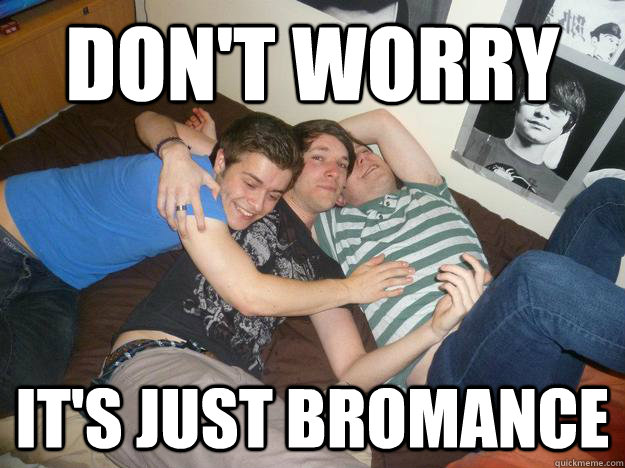
Bromance, as defined by its
first entry on Urban Dictionary, is the "complicated love and affection shared by two straight males" (fletchlives, 2005). But what does it
really mean? I'll get to that. First, a brief examination of its short existence in popular language:
I started by looking for an oppposite. Everything must have an opposite, right? According to Wikipedia, it's called a "womance." Something that I notice right away between the two is that the entire Wikipedia article for womance fits on my screen. The bromance article is several times longer and features a history dating back to Aristotle, along with a list of cross-cultural celebrity media portrayals of the concept.
A similar result can be found if you search plot keywords on IMDb. Bromance brings up
97 titles, with films as diverse as Due Date, The Kings Speech, and Fox and the Hound. Searching for womance yields zero results.
Likewise, on Urban Dictionary, there are 79 entries for bromance, while there are only 10 entries for womance. Furthermore, 8 of those 10 entries for womance include in the definition some sort of connection to bromance, such as it being an alternative or an opposite to the term. Out of all the bromance entries, none of them mention the term womance. This suggests that the term womance only exists because the term bromance exists. We humans like things to be black and white, so if one thing exits, an opposite must exist as well.
Now, I know Wikipedia, IMBd, and Urban Dictionary are not top level academic sources. However, I think they are applicable to the study of the bromance concept because it is largely a pop culture term. Though Google Trends shows that bromance first appeared as a search term in 2006, the Urban Dictionary definition was posted in 2005, and Merriam-Webster shows that the term was first used in 2004 (though it doesn't mention where). It appears that the term took off in 2009, most likely due to an MTV reality show with Brody Jenner called
Bromance. Google Trends shows that the term dropped after 2009, but that it stayed above the levels previous to that year, suggesting that Jenner's show solidified the term into our pop culture language.
So why is the term so important and prevalent?
Moving out of pop culture it is interesting to examine the bromance concept and what it really signifies in our society. Even the Urban Dictionary definitions hint that this is more than a close friendship between two men. So, what's really going on here?
I had the hypothesis that the term came into popular use to downplay the "gayness" of two close male
friends. In a heteronormative culture that values masculinity, it seems counterintuitive that a male would have an intimate relationship with another male. Intimate in this context meaning that they openly share their feelings and spend a significant amount of time alone with each other.

I went searching for some peer reviewed articles on this concept, and I found one. Elizabeth J. Chen (2012) writes extensively about the past, present, and future of the bromance, and its implications for our society in an article humorously titled Caught In a Bad Bromance. The first thing that she mentions is that close male relationships are nothing new. She cites the same Aristotle text as the Wikipedia article and notes that psychologists recognize that boys have a need for intimate relationships.
So if the idea of close male friendships has been around for so long, why does our culture seem to make such a big deal of it now? Even Chen notes that "by giving [it] linguistic distinction, society gives bromances elevated status" (p. 247). Well, she provides an answer, explaining that bromance provides a safe context for men to avoid "anxiety about how others perceive their sexuality" (p. 248).
Furthermore, a bromance provides a safe context for men to step out of the competitive world of masculinity that many American men exist in. Dowd (as cited in Chen, 2012) states that "masculinity is often described as something never attained but rather something that must be consistently achieved on a daily basis" (p. 257). For men attempting to achieve masculinity, their competition is other men. They need to be stronger, have more women, and have nicer things then other men. However, within a bromance, there is no such competition. Chen says that "this form of male friendship is predicated on love and care" (p. 258). In fact, a bromance may form a team, and that tem begins competing with other terms. They are, in a sense, a single unit.
In conclusion, bromance provides a context for men to engage in a close friendship with other men, without fear of being stigmatized as gay. As our society moves away from heteronormativity, and as masculinity becomes less defined by competition, perhaps there will be less of a need for this term. However, considering how popular of a term it is in popular culture, it doesn't appear to be going away anytime soon.
As a side note, it will be interesting to see how its sister term, womance, fares in the coming years. It doesn't look good though, as I can't even find a womance meme to share. Maybe the term "girlfriend" covers that well enough, and is the true opposite to bromance. When is the last time you ever heard a heterosexual male call another heterosexual male his boyfriend? As a label-loving culture, though, I would predict we would probably just continue to create more and more terms to describe our everyday lives.
References:
-Bromance. (2014). Retrieved July 29, 2014 from Wikipedia: http://en.wikipedia.org/wiki/Bromance
-Bromance. (n.d.). In Merriam-Webster. Retrieved from http://www.merriam-webster.com/dictionary/bromance
-Chen, E. J. (2012). Caught in a bad bromance. Texas Journal Of Women & The Law, 21(2), 241-266.
-Fletchlives. (2005, May 30). Bromance. [Web posting]. Retrieved from http://www.urbandictionary.com/define.php?term=Bromance



